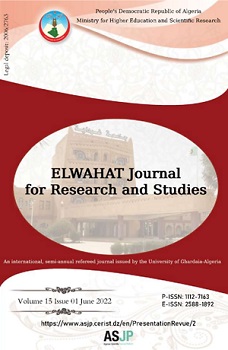Etude des paramètres physico-chimiques et de l’activité antioxydante de trois vinaigres de cidre traditionnels issus de trois variétés de pomme de la région de Midelt au Maroc
Abstract
Le vinaigre était connu par la plupart des anciennes civilisations. Il est utilisé comme condiment, comme agent de conservation ou, dilué dans l‟eau, comme boisson. Ce bioproduit est obtenu exclusivement par procédé biotechnologique d‟une double fermentation (alcoolique et acétique) de liquides ou d‟autres substances agricoles. Dans notre étude on s‟intéresse à trois vinaigres de cidre produits à partir de trois variétés de pomme : VCP1 (RédDélicious) VCP2 (mélanges de trois variétés RédDélicious+ Golden Délicious+starkrimson) et VCP3 (Golden Délicious). Les résultats d'analyses de quelques paramètres physico-chimiques et biochimiques montrent que les vinaigres étudiés se caractérisent par un pH acide, des teneurs importantes en matières sèches, une conductivité électrique élevée et une forte concentration en sel minéraux avec une prédominance de K+ dont le taux maximal (41,86 mg/l) se trouve dans la variété de vinaigre VCP2. La présente étude révèle également une teneur en acidité totale de 4,35±0,69% pour la variété VCP1. La teneur la plus élevée en polyphénols de l‟ordre de 2,02±0,05 mg EAG/L est déterminée chez la variété VCP1 et celle de l‟activité antioxydante est de l‟ordre de 19,48±2,01 mg EAA/ml chez la même variété de vinaigre VCP1.
Mots clés : Vinaigre de cidre de pomme, polyphénols totaux, activité antioxydante totale, paramètres physicochimiques, Midelt.
References
Akin, H 2008. Evolution du pH pendant la fermentation alcoolique modélisation et interprétation métabolique. Thèse doctorat, Institut National Polytechnique de Toulouse, option : Génie des Procédés et Environnement : 121.
Alvarez-Suarez, J.M.; Tulipani, S.; Diaz, D.; Estevez, Y.; Romandini, S.; Giampieri, F.; Damiani, E.; Astolfi, P.; Bompadre, S.; Battino, M.M.A.B. 2010, Antioxidant and antimicrobial capacity of several monofloral Cuban honeys and their correlation with color, polyphenol content and other chemical compounds. Food Chem. Toxicol. 48, 2490–2499.
Audigie CL.; Figarelle J; et Zonszain F. 1984; Manipulations d‟analyses biochimiques; 1ére édition, Ed. Doin, Paris, 274 p.
Baydar, N.G.; Sagdic, O.O.E.E.; Ozkan, G.; Cetin, S. 2006, Determination of antibacterial effects and total phenolic contents of grape (Vitisvinifera L.) seed extracts. Int. J. Food Sci. Technol. 41, 799–804.
Buonocore G, Perrone S, Tataranno MN. 2010. Oxygen toxicity: chemistry and biology of reactive oxygen species. Semin Fetal Neonatal Med 15:186–90.
Chang J, Fang TJ. 2007. Survival of Escherichia coli O157:H7 and Salmonella entericaserovarstyphimurium in iceberg lettuce and the
ElWahat pour les Recherches et les EtudesVol.10 n°1 (2017) : 37-50
Driss Ousaaid, Ismail Mansouri, Mouad Rochdi, Badiaa Lyoussi et Ilham El Arabi 47
antimicrobial effect of rice vinegar against E. coli O157:H7. Food Microbiol 24:745–51.
Chavez, J.H.; Leal, P.C.; Yunes, R.A.; Nunes, R.J.; Barardi, C.R.; Pinto, A.R.; Simoes, C.M.; Zanetti, C.R. 2006, Evaluation of antiviral activity of phenolic compounds and derivatives against rabies virus. Vet. Microbiol. 116, 53–59.
Davalli, P.; Rizzi, F.; Caporali, A.; Pellacani, D.; Davoli, S.; Bettuzzi, S.; Brausi, M.; D‟Arca, D. 2012, Anticancer activity of green tea polyphenols in prostate gland. Oxid. Med. Cell. Longev. 984219.
Davalos A, Bartolome B, Gomez-Cordoves C. 2005. Antioxidant properties of commercial grape juices and vinegars. Food Chem 93:325–30.
Dowson V. H. Z. et Aten A. 1963, Récolte et conditionnement de dattes; Ed. FAO, Rome: 11-44.
Food-allergens, 2012. Site Internet du symposium sur les allergènes alimentaires. Espace « Allergen Data Collections », fiche : Apple (Malus domestica), chapitre 5 : Composition of Apple. http://www.food-allergens.de/..
Guiraud J.P 1998. Microbiologie alimentaire. Edition DUNOD1998, Paris : 615.
Guyot S. Symoneaux R. Le Quéré J.-M, Bauduin R 2014. Les Polyphénols de la Pomme aux Cidres : diversité variétale et procédés, facteurs clé de la modulation des saveurs et des couleurs, Innovations Agronomiques 42,105-123.
Hashim Matloob M, 2014. Zahdi date Vinaigre : Production et caractérisation. American Journal of Food Technology, 9:. 231.
Jung, H.J.; Hwang, I.A.; Sung, W.S.; Kang, H.; Kang, B.S.; Seu, Y.B.; Lee, D.G. 2005, Fungicidal effect of resveratrol on human infectious fungi. Arch. Pharm. Res. 28, 557–560.
Khurana, S.; Venkataraman, K.; Hollingsworth, A.; Piche, M.; Tai, T.C. 2013, Polyphenols: benefits to the cardiovascular system in health and in ageing. Nutrients 5, 3779–3827.
Kolodziejczyk, K.; Sojka, M.; Abadias, M.; Vinas, I.; Guyot, S.; Baron, A. 2013, Polyphenol composition, antioxidant capacity, and antimicrobial activity of the extracts obtained from industrial sour cherry pomace. Ind. Crop. Prod. 51, 279–288.
Larrosa, M.; Luceri, C.; Vivoli, E.; Pagliuca, C.; Lodovici, M.; Moneti, G.; Dolara, P. 2009, Polyphenol metabolites from colonic microbiota exert anti-inflammatory activity on different inflammation models. Mol. Nutr. Food Res. 53, 1044–1054.
Maes M, Galecki P, Chang YS, Berk M. 2011. A review on the oxidative and nitrosative
stress (O&NS) pathways in major depression and their possible contribution to the (neuro)degenerative processes in that illness. ProgNeuropsychopharmacolBiolPsychiatry 35:676–9.
ElWahat pour les Recherches et les EtudesVol.10 n°1 (2017) : 37-50
Driss Ousaaid, Ismail Mansouri, Mouad Rochdi, Badiaa Lyoussi et Ilham El Arabi 48
MAPM, 2014. Note de veille „pomme‟ ministère de l‟agriculteur et de la pèche maritime.
Martinez-Dominguez, E.; de la Puerta, R.; Ruiz-Gutierrez, V. 2001, Protective effectsuponexperimental inflammation models of a polyphenol-supplementedvirgin olive oildiet. Inflamm. Res. 50, 102–106.
Masino F., Chinnici F., Franchini G. C., Ulrici A and Antonelli A.; 2005, A study of relationship among acidity, sugar and furanic compounds concentrations in set of casks for AcetoBalsamicoTradizionale of Reggio Emilia by multivariate technique; Food chemistry: 673-679.
Masino F., Chinnici F., Bendini A., Montevicchi G. and Antonelli A.; 2008, A study on relationships among chemical, physical, and qualitative assesment in traditional balsamic vinegar; Rev. Food chemistry: 90-95.
Medina, E., C. Romero, M. Brenes, and A. De Castro. 2007. “Antimicrobial Activity of Olive Oil, Vinegar, and Various Beverages against Foodborne Pathogens”. Journal of Food Protection. 70(5):1194 – 1199.
Nassar Ayoub Abdellatif Omar, Amal Nor Edeen Ahmad Allithy, Firas Mahmoud Faleh, Reham A. Mariah, Mongi Mohamed Ahmed Ayat, SherineRagabShafik, Samah A. Elshweikh, Salah Mohamed El Sayed. 2015, Apple Cider Vinegar (A Prophetic Medicine Remedy) Protects against Nicotine Hepatotoxicity: A Histopathological and Biochemical Report. American Journal of Cancer Prevention, Vol. 3, No. 6, 122-127
Nada KhazalKadhim Hindi 2013, In vitro Antibacterial Activity of Aquatic Garlic Extract, Apple Vinegar and Apple Vinegar - Garlic Extract combination. American Journal of Phytomedicine and Clinical Therapeutics ISSN 2321 – 2748.
Nadtochiy, S.M.; Redman, E.K. 2011, Mediterranean diet and cardioprotection: The role of nitrite, polyunsaturated fatty acids, and polyphenols. Nutrition 27, 733–744.
Ould el hadj M. D.;2001.Qualité hygiénique et caractéristiques physico-chimiques du vinaigre traditionnel de quelques variétés de dattes de la cuvette de Ouargla; Revue des énergies renouvelables, NS, Biomasse, CDER, Alger, 87-92.
Plumed-Ferrer, C.; Vakevainen, K.; Komulainen, H.; Rautiainen, M.; Smeds, A.; Raitanen, J.E.; Eklund, P.; Willfor, S.; Alakomi, H.L.; Saarela, M.; von Wright, A. 2013, The antimicrobial effects of wood-associated polyphenols on food pathogens and spoilage organisms. Int. J. Food Microbiol. 164, 99–107.
Popovici C, Saykova I, Tylkowski B, 2009. Evaluation de l‟activité antioxydant des composes phénoliques par la réactivité avec le radical libre DPPH. Revue de génie industriel, 4,25-39.
Rhanem M 2010. Etude climatique en moyenne montagne méditerranéenne: le cas de la localité de Midelt dans le haut bassin versant de la Moulouya (Maroc) pour des fins bioécologiques Quad. Bot. Amb. Appl., 21 (165-187.
ElWahat pour les Recherches et les EtudesVol.10 n°1 (2017) : 37-50
Driss Ousaaid, Ismail Mansouri, Mouad Rochdi, Badiaa Lyoussi et Ilham El Arabi 49
Rejsek f. 2002; Analyses des eaux. Aspects réglementaire et techniques; Ed. Scéren, Paris, 69-74.
Saadi Z, Fedan B, Laadila M &Kaoukaya A. 2003, Les tidalites liasiques de la Haute Moulouya et du Moyen Atlas méridional (Maroc) : dynamique sédimentaire et contexte paléogéographique, Bulletin de l‟Institut Scientifique, Rabat, section Sciences de la Terre, n°25, 55-71
Santangelo, C.; Vari, R.; Scazzocchio, B.; Di Benedetto, R.; Filesi, C.; Masella, R. 2007, Polyphenols, intracellular signalling and inflammation. Ann. Ist. Super. Sanita 43, 394–405.
Santhakumar, A.B.; Kundur, A.R.; Fanning, K.; Netzel, M.; Stanley, R.; Singh, I.2015, Consumption of anthocyanin-rich queen garnet plum juice reduces platelet activation related thrombogenesis in healthy volunteers. J. Funct. Food. 12, 11–22.
Santhakumar, A.B.; Bulmer, A.C.; Singh, I. 2013, A review of the mechanisms and effectiveness of dietary polyphenols in reducing oxidative stress and thrombotic risk. J. Hum. Nutr. Diet., 27, 1–21.
Sato, M.; Ramarathnam, N.; Suzuki, Y.; Ohkubo, T.; Takeuchi, M.; Ochi, H. 1996, Varietal differences in the phenolic content and superoxide radical scavenging potential of wines from different sources. J. Agric. Food Chem. 44, 37–41.
Shah, Q.A.; F. Bibi, M; and A.H. Shah, 2013. Anti-Microbial Effects of Olive Oil and Vinegar against Salmonella and Escherichia coli. The Pacific Journal of Science and Technology, Volume 14. Number 2.
Sebihi A. 1996. Contribution à l‟étude de quelques paramètres de la qualité hygiénique et biochimique de vinaigre traditionnel de quelques variétés de dattes de la cuvette de Ouargla. Thèse ing., INFS/AS, Ouargla.
Sengun IY, Karapinar M. 2004. Effectiveness of lemon juice, vinegar and their mixture in the elimination of Salmonella typhimurium on carrots (Daucuscarota L.). Intl J Food Microbiol 96:301–5.
Serrano R., Delafuente G 1974. Regulatory properties of the constitutive hexose transport in Saccharomyces cerevisiae. Mol. Cell. Biochem, 5: 161-171.
Singh, I.; Mok, M.; Christensen, A.M.; Turner, A.H.; Hawley, J.A. 2008, the effects of polyphenols in olive leaves on platelet function. Nutr. Metab. Cardiovasc. Dis. 18, 127–132.
Singleton V. L, Orthofer R, Lamuela-Raventos R. M, 1999, Analysis of total phenols and other oxidation substrates and antioxidants by means of Folin–Ciocalteu reagent. Methods in Enzymology, 299, 152–178.
Slusarczyk, S.; Hajnos, M.; Skalicka-Wozniak, K.; Matkowski, A.B.B.A. 2009, Antioxidant activity of polyphenols from Lycopus lucidus Turcz. Food Chem., 113, 134–138.
Vita, J.A. Polyphenols and cardiovascular disease: Effects on endothelial and platelet function. Am. J. Clin. Nutr. 2005, 81, 292S–297S.
ElWahat pour les Recherches et les EtudesVol.10 n°1 (2017) : 37-50
Driss Ousaaid, Ismail Mansouri, Mouad Rochdi, Badiaa Lyoussi et Ilham El Arabi 50
Wu J., Gao H., Zhao L., Liao X., Chen F., Wang Z., Hu X. (2006): Compositional characterization of some apple cultivars. Food Chemistry, 103: 88-93.
Zamora F 2009. Biochemistry of Alcoholic Fermentation (chapter 1). Journal of Wine Chemistry and Biochemistry:26.
Zhao, X.; Pang, L.; Li, J.; Song, J.L.; Qiu, L.H. 2014, Apoptosis inducing effects of Kuding tea polyphenols in human buccal squamous cell carcinoma cell line BcaCD885. Nutrients, 6, 3084–3100.






